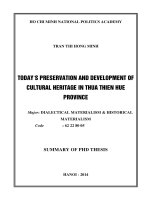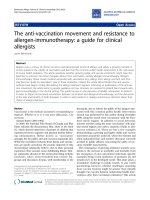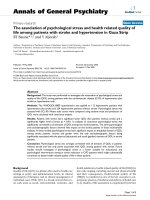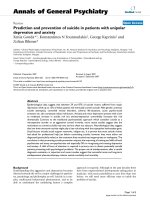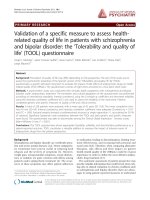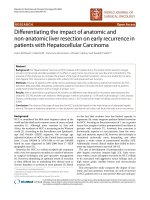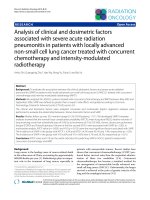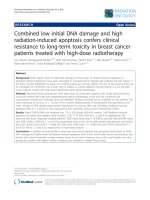Summary of Phd thesis: Clinical, subclinical features and resistance to tyrosine kinase inhibitor of lung cancer patients with EGFR mutations
Bạn đang xem bản rút gọn của tài liệu. Xem và tải ngay bản đầy đủ của tài liệu tại đây (646.57 KB, 29 trang )
MINISTRY OF EDUCATION AND TRAINING
MINISTRY OF HEALTH
HANOI MEDICAL UNIVERSITY
LE HOAN
CLINICAL, SUBCLINICAL FEATURES AND
RESISTANCE TO TYROSINE KINASE INHIBITOR
OF LUNG CANCER PATIENTS WITH
EGFR MUTATIONS
SPECIALTY: PULMONARY MEDICINE
CODE: 62.72.01.44
SUMMARY OF PHD THESIS
HA NOI - 2020
THE RESEARCH WAS COMPLETED
IN HANOI MEDICAL UNIVERSITY
Supervisor: Prof. NGO-QUY Chau, MD. PhD
Reviewer 1: A. Prof. NGUYEN Dinh Tien, MD. PhD
Reviewer 2: A. Prof. NGUYEN Tuyet Mai, MD. PhD
Reviewer 3: A. Prof. CHU Thi Hanh, MD. PhD
The thesis is defended in front of the Thesis Committee of the
University at Hanoi Medical University.
The thesis can be accessed at:
- Vietnam National Library
- Hanoi Medical University Library
INTRODUCTION
1. Rationale
Lung cancer is recently the leading cause of cancer related mortality in
the world. Until now, a number of gene mutations have been identified to be
related to the pathogenesis of lung cancer with the most common ones are
mutations of EGFR gene. The targeted therapy with tyrosine kinase inhibitors
(TKIs) is proved to be an effective therapy for non small cell lung cancer with
EGFR mutation. However, researches showed that after 12 to 24 months with
EGFR-TKIs therapy, most of patients developed the drug-resistance. Several
mechanisms underlying drug-resistance to EGFR-TKIs have been identified
such as the development of new mutations of EGFR gene, the amplification or
increasing the expression of other genes; as well as the transformation of
cancer cells. Among those, the most important mechanisms are induced
T790M mutation and MET amplification, which account for over 70% of
EGFR-TKIs resistant cases. In Viet Nam, EGFR mutations targeted therapies
have been used recently and drug-resistance has been found in clinical practice.
Therefore, it is necessary to study the EGFR-TKIs resistance in lung cancer
patients in order to identify the mechanism of the resistance and to point out
the strategy for the next period of those patients.
2. Objectives
1. To describe the clinical and subclinical features of lung cancer
patients with EGFR mutations before TKIs therapy and in the
relapsed period.
2. To identify the T790M mutation and MET amplification in patients
with lung cancer and EGFR-TKIs resistance and the relationship with
clinical and subclinical features.
3. Scientific and practical meanings
Identification of the clinical and subclinical features of lung cancer
patients with EGFR mutations help us to generalize specific features of this
patients group, for individualizing in treatment. Knowing the features of
patients at the time of they develop EGFR-TKIs resistance can support for the
recommendations of clinical practice to find out the resistance early.
Studying the mechanism underlying EGFR-TKIs resistance in lung cancer
patients with EGFR mutations is the scientific evidence to choose the
following therapy for those patients. Patients with EGFR-T790M can be
treated with the later generations of EGFR-TKIs such as afatinib, dacomitinib,
osimertinib,…While patients with MET amplification can be treated with MET
inhibitors like crizotinib, tivantinib,...
4. Novelty
It is the first research in Viet Nam to study of clinical and subclinical
features of lung cancer patients with EGFR mutations and the mechanism
underlying EGFR-TKIs resistance. The results of this research can provide
clinical doctors with the view of targeted therapy including treatment outcome,
drug resistance, therefore they can have a appropriate approach for patients
developing drug resistance.
5. Thesis structure
The thesis includes 118 pages (without References and Appendix),
divided into 7 parts:
-
Introduction: 3 pages
Chapter 1: Literature review, 35 pages
Chapter 2: Methodology, 15 pages
Chapter 3: Results, 29 pages
Chapter 4: Discussions, 31 pages
Conclusions: 4 pages
Recommendations: 1 page
The thesis includes 26 tables, 23 charts, 09 figures. It has 148 references
in Vietnamese and English. Appendixes include Research Forms and the list of
66 lung cancer patients.
Chapter 1: LITERATURE REVIEW
1. Overview of lung cancer
Lung cancer is the most common and has the highest rate of mortality in all
kinds of cancer. According to the GLOBOCAN 2018 database, it was estimated
2.09 millions new lung cancer cases and 1.76 millions lung cancer deaths
worldwide. In the United States, lung cancer is the leading cause of cancer death
and the second-ranked cancer incidence in both genders. There was an estimated
228150 new lung cancer cases and 142670 lung cancer deaths in the US in 2019,
account for 23% of all cancer deaths.
According to researches, lung cancer is more common in males. In 2018,
it was estimated that there were 1377500 lung cancer cases in males,
accounting for 66% all lung cancer cases, with the gender rate of 1.94/1. In
developing countries, the gender rate may be higher, while in developed
countries, the prevalence of lung cancer in female is rising. In the US in 2019,
those numbers was 116440 cases and 111710 cases respectively. In Viet Nam,
according to GLOBOCAN 2018 database, there was an estimated 23667 new
lung cancer cases, with the 2nd ranked in all cancers, after liver cancer.
Smoking is considered the major risk factor of lung cancer, that
approximately 80- 85% of lung cancer patients in the world smoked. Other risk
factors of lung cancer include: air pollution, ionized radiation, occupational
exposure, virus, diet, history of respiratory diseases.
Researches of molecular level revealed that the development of lung
cancer had several periods with the interactions of some factors, the
sensitization of genes, cumulative process of gene mutations of oncogenes and
tumor suppressor genes. Genes regulations is originally smooth and tight, when
it is impaired it can lead to the abnormal enhancement or inhibition of
functional genes.
With whole genome sequencing of a clone of lung cancer cells, it is partly
understood about intracellular mediators signaling pathway related to the
activation of oncogenes and deactivation of suppressor genes. The activation of
oncogenes through the signaling pathway of EGFR and other tyrosine kinase
receptors such as MET, Her-2, c-KIT, IGF-1R... in addition with the following
activation of RAS/RAF/MEK/MAPK, PI3K/AKT and JAK/STAT can lead to
the nonstop proliferation, differentiation, invasion, metastasis and resistance to
apoptosis.
In normal cells, the activation of EGFR is necessary for several crucial
functions of cells such as the proliferation and differentiation. But the extreme
activation due to gene mutations can lead to the abnormal proliferation as well
as the transformation of cells. In addition, the impaired activity of EGFR due to
gene mutation can lead to maglinant disorders. The mutation in exon 18- 21
makes EGFR to be in activating status independent from mediators.
Features of EGFR mutations in NSCLC patients include: high rate in nonsmokers, more common in adenocarcinoma type compared to other types of
NSCLC, females are more common than males, higher rate in East Asian
patients compared to other races.
2. EGFR-TKIs therapy for lung cancer
EGFR mutations had a quite high prevalence in NSCLC patients,
especially the adenocarcinoma and in non-smokers. Researches in Europe and
North America showed the prevalence of mutations is approximately 17%,
while it is up to 78.8% in East Asia. With whole genome sequencing,
researchers can identify a number of mutations of EGFR influencing the
response to TKIs. The common mutation of EGFR being sensitive to TKIs is
LREA (exon 19) and L858R (exon 21). Some EGFR-TKIs being used recently
are erlotinib, gefitinib, afatinib. Clinical trials showed that EGFR-TKIs help
prolong non-disease survival time better than standard chemotherapy. 6 phase
III RCTs compared EGFR-TKIs with standard chemotherapy as the first step
treatment for lung cancer patients with sensitive EGFR mutations, and all of
those RCTs revealed the rate of response and disease-free survival in the group
treated with EGFR-TKIs, but no difference of survival.
An important question is that which therapy should be chose if patients
relapse when using TKIs. It is still lack of strong evidence. Various approach
can be done, such as examining if the tumor transforms into small cell type (by
another biopsy) or considering chemotherapy with platin if patients can tolerate
it. Thereafter, TKIs can be used again if the chemotherapy fails. Other choices
include continuing using TKIs if the tumor grows gradually, switching to
another TKI, optical therapy or cell toxic therapy. To understand the resistant
mechanism, another biopsy should be done and clinical trial should be
considered.
3. EGFR-TKIs resistance in lung cancer patients
Clinical trials showed good results of EGFR-TKIs therapy for lung cancer
patients with EGFR mutations. But, after 12 to 24 months of treatment, the
cancer relapsed in most of the patients who had good results before. The
targeted therapy was no longer effective becaused of EGFR-TKIs resistance.
Until now, several mechanisms underlying EGFR-TKIs resistance had been
studied (Figure 1.1).
The most common cause of EGFR-TKIs resistance is the development of
mutations in EGFR itself. It is the mutation of EGFR-T790M (the Threonin at
acid amin position 790 was substituted by Methionine) at the exon 20. This
mutation accounts for 40-55% of the cases. Recently, there are 2 mechanism
suggested by researchers to explain the relationship between T790M mutation
and the resistance of tumor cells. At the aspect of structure, the substitution
from Threonine to Methionin changed the reaction position of kinase, inhibited
the binding of erlotinib and gefitinib. At the aspect of interactions between
biological particles, the T790M mutation restored the affinity of kinase with
ATP while reduced the affinity of erlotinib and gefitinib.
One less common mechanism of EGFR-TKIs resistance is MET
amplication. MET encode for MET protein which plays a role of surface
receptor to receive signal from HGF. By the activity of tyrosine kinase, MET
can lead to the phosphorylization of ERBB3, maintaining the activation of
PI3K/Akt signaling pathway, which can activate the process of invasion,
metastasis and vascular proliferation of the tumor. In this case, in stead of
relying on the EGFR, the signal for proliferation of tumor cells relies on MET
and MET downstream signaling pathway. As a result, EGFR-TKIs becomes
deactivated.
Alongsides, some other mechanisms can be identified includes ERBB2
amplication, transformation from NSCLC to small cell lung cancer or KRAS,
BRAF mutations.
Figure 1.1: Mechanism underlying EGFR-TKIs resistance
Chapter 2: METHODOLOGY
2.1. Subjectives
We recruited 66 patients with a diagnose of NSCLC with TKIs sensitive
EGFR mutations, treated with TKIs (erlotinib hoặc gefitinib), having good
response or stable in at least 6 months and relapsed after that.
2.1.1. Inclusion criteria
- Patients diagnosed with NSCLC by histopathological evidence according to
WHO.
- Patients were treated in Hospital K, Center of Nuclear Medicine and
Oncology in Bach Mai Hospital and Respiratory Department in Hospital
108 from June 2014 to June 2019.
- Patients met the criteria of American Society of Clinical Oncology to
access the TKIs resistance of NSCLC:
+ Diagnosed with NSCLC with TKIs sensitive EGFR mutations
+ Treated with EGFR-TKIs (erlotinib or gefitinib).
+ Responsed or stable in at least 6 months
+ Relapsed or developed new lesions despite of treatment with erlotinib
or gefitinib.
+ No systemic chemotherapy after stopping erlotinib or gefitinib and
before a new episode of treatment.
2.1.2. Exclusion criteria
- Lung cancer patients treated with EGFR-TKIs without confirmed TKIs
sensitive EGFR mutations.
- Patients without response or stable state after at least 6 months of EGFRTKIs treatment.
- Patients refused to participate in the research
2.2. Methods
2.2.1. Study designs
-
Prospective descriptive study with case series
2.2.2. Study process
2.2.2.1. Describing clinical, subclinical features of NSCLC with EGFR mutations before
TKIs therapy and after relapse.
Clinical, subclinical features were documented in a research medical
report, including:
Basic information:
- Age, Gender, Occupation, Address
Clinical features :
-
Respiratory symptoms: cough, sputum, hemoptysis, chest pain, dyspnea
Systemic symptoms : fatigue, weight loss, lymph nodes
Access ECOG according to WHO
Invasive or local invasive symptoms: hoarse, choking, superior vena cava
compression syndrome, Pancoast Tobias syndrome
Metastatic symptoms: headache, abdominal pain, muscoskeletal pain,
pleural effusion, pericardial effusion, etc.
Paraneoplastic syndromes
Family history of lung cancer
Patients„ history: smoking, comorbidity diseases
Subclinical features:
-
Location, size, number, morphological and invasive characteristics of
tumors on chest Xrays and contrast enhanced chest CT
Histopathology according to WHO criteria in 2015 for lung and pleural
tumor.
TNM staging: According to TNM classification 8th edition 2018
- EGFR mutations analysis which EGFR mutations were TKIs sensitive.
2.2.2.2. Identification of TKIs resistance of lung cancer patients with EGFR mutations.
Accessing the duration to develop EGFR_TKIs resistance
Analyzing clinical factors that could affect the response to EGFR-TKIs: age,
gender, smoking status, histopathological feature, TKIs sensitive gene
mutations
Obtaining sample at the time developing drug resistance of patients who
were suspected to have EGFR-TKIs resistance according to ASCO 2009,
including: another biopsy under CT guided or bronchoscopy; lymph nodes
biopsy; biopsy of metastatic lesion such as liver, bone, vetebra; cell-block
of metastatic fluid.
Gene analyzing to identify abnormalities related to EGFR-TKIs resistance
was done at Gene and Protein Research Center at Hanoi Medical University,
including:
- Identification resistant mutations of EGFR using Scorpions ARMS realtime PCR
- Identification of MET amplication using FISH
Analyzing clinical factors that could affect the development of EGFRT790M mutation and MET amplication leading to EGFR-TKIs resistance:
age, gender, smoking status, histopathological feature
2.3. Data analysis
- Data was managed, analyzed with the statistic software SPSS 22.0.
- Using statistic algorithm including descriptive test to calculate the rates,
average, comparison, analyzing
- Difference was statistical significant with p <0,05.
2.4. Research ethnic
- Participants were voluntary and had the right to withdraw of the research
- Patients‟ personal data was secured
- Techniques, procedures performed on patients were warranted to be right
according to Ministry of Health.
- The research was conducted for the scientific purpose but not any other one.
- The research was approved by the Ethnic Committee of Hanoi Medical
University.
Chapter 3: RESULTS
By studying 66 lung cancer patients with EGFR mutations, treated with
EGFR-TKIs, thereafter developed EGFR-TKIs resistance, the results were as
below:
3.1. Clinical and subclinical features of patients with lung cancer with
EGFR mutations before TKIs therapy and in the relapsed period
3.1.1. Basic characteristics
Table 3.1: Basic characteristics of research patients (n=66)
Characteristics
n
%
34
32
36
10
20
16
12
10
51.5
48.5
54.5
15.2
30.3
18.2
24.2
15.2
Age: 60,6 ± 10,7 years (min: 26; max: 80 years)
Gender
Smoking
Cormobidities
Male
Female
Non-smoker
Ex-smoker
Current smoker
Cardiovascular diseases
Pulmonary diseases
Metabolic disorders
Comments: Gender ratio was approximately 1/1; 54.5% of patients were nonsmokers; 57.6% of patients had cormobidities
3.1.2. Clinical features of patients with NSCLC with EGFR mutations
Table 3.2: Clinical features of patients with NSCLC with EGFR mutations (n=66)
Symptoms
Chest pain
Cough
Dyspnea
Hemoptysis
Weight loss
Fever
Peripheral lymph node
Headache
Spinal pain
Muscoskeletal pain
Abdominal pain
Hoarse
Hiccup
Choking
SVC compression syndrome
Pancoast Tobias syndrome
Before therapy
n
%
40
60.6
32
48.5
16
24.2
8
12.1
24
36.3
8
12,1
16
24.2
16
24.2
14
21.2
12
18.2
6
9.1
4
6.1
3
4.5
3
4.5
3
4.5
2
3,0
Relapse
n
32
38
30
0
10
2
8
10
8
6
6
5
0
0
0
0
%
48.5
57.6
45.5
0
15.2
3.0
12.1
15.2
12.2
9.1
9.1
7.6
0
0
0
0
Comments:
-
The most common respiratory symptoms were chest pain, cough and
dyspnea
- The most common systemic symptoms were weight loss, peripheral lymph
node
- The most common metastatic symptoms were headache, spinal pain,
muscoskeletal pain.
- In general, symptoms when relapse were similar to those before therapy but
with lower rate.
3.1.2. Subclinical features of patients with NSCLC with EGFR mutations
Imaging characteristics
- Size of the primary tumor: 12.1% of patients had tumor diameter of >2 to
≤3cm; 36.4% of patients had tumor diameter of >3 to ≤5cm; 45.4% of
patients had tumor diameter of >5 to ≤7cm; 6.1% BN had tumor > 7cm, no
patient had tumor < 2cm.
- Location of the primary tumor: 27.3% of patients had tumor of upper lobe
of the right lung; 12.1% of patients had tumor of middle lobe of the right
lung; 21.2% of patients had tumor of lower lobe of the right lung; 21.2% of
patients had tumor of upper lobe of the left lung; 18.2% of patients had
tumor of lower lobe of the left lung.
- Secondary lesions: 21.2% of patients had pleural effusion; 9.1% of patients
had pericardial effusion; 21.2% of patients had brain metastasis; 21.1% had
bone or vertebra metastasis; 18.2% had adrenal metastasis and 9.1% of
patients had liver metastasis.
- Imaging at the time of disease relapse: 63.6% of patients increased
primary tumor size; 31.8% of patients had new lung lesion; some of
patients developed from previous metastatic lesions, others had new
metastatic lesions.
Histopathologic characteristics: 98.5% were adenocarcinoma; 1.5% was
adenosquamous carcinoma.
EGFR mutations: 54.5% had LREA; 44% had L858R and 1.5% had
G719S.
3.2. Identification T790M mutation of EGFR gene, MET amplication in lung
cancer patients with EGFR-TKIs resistance and the relationship with clinical
and subclinical features
3.2.1. Effectiveness of EGFR-TKIs in treating lung cancer patients with EGFR
mutations
2 first generation EGFR-TKIs including erlotinib (53%) and gefitinib
(47%) were used as first step therapy for patients with EGFR mutations and
sensitive to TKIs.
Adverse effects of EGFR-TKIs: Skin rash (22.7%); nausea, vomit (21.2%);
fatigue, appetite loss (18.2%); elevated liver enzyme (16.7%); stool
disorders (15.1%); paronychia (6.1%); hair loss (4.5%); muscle pain (1.5%).
Patients’ response after 6 months of treating with EGFR-TKIs:
Table 3.3: Patients’ response after 6 months
of treating with EGFR-TKIs (n=66)
Patients’ response
Totally response
Partly response
Stable
Relapse
Total
n
0
58
8
0
66
%
0
87.9
12.1
0
100
Comments:
- Most of patients had partly response after 6 months treating with EGFRTKIs, accounting for 87.9%
- 12.1% of patients were stable after 6 months treating with EGFR-TKIs
- No patient had totally response after 6 months treating with EGFR-TKIs
Table 3.4: Performance status before and after treatment (n=66)
Performance
status
PS 0-1
PS 2-4
Total
Before
n
40
26
66
After
%
60.6
39.4
100
n
52
14
66
%
78.8
21.2
100
p
p=0.035
Comments:
- After 6 months, number of patients having PS0-1 increased significantly
- After treatment, patients‟ performance status improved significantly
(p=0.035)
Time until relapse
Chart 3.1: Progression-free survial (PFS) (n=66)
Comments:
- Average time from the beginning of EGFR-TKIs therapy until relapse was
14.48 ± 3.9 months.
- Median PFS was 14 months; min: 8 months, max: 26 months.
- 39.3% of patients relapsed after 6-12 months; 42.4% after 13-18 months;
15.3% after 19-24 months; 3% after over 24 months.
The influence of clinical and subclinical factors on PFS
- Average PFS was not different between males (13.8 months; 95%CI 12.614.9 months) and females (15 months; 95%CI 13.5-16,5 months) (p=0.180)
(Chart 3.2A).
- Average PFS was different significantly between ≤60 year-old group (15.7
months; 95%CI 14.3-17.1 months) and >60 year-old group (13.3 months;
95%CI 12.1-14.5 months) (p=0.028) (Chart 3.2B).
- Average PFS was not different between smokers (13.8 months; 95%CI
12.6-15.1 months) and non-smokers (14.8 months; 95%CI 13.4-16.1
months) (p=0.324) (Chart 3.2C).
- Average PFS was different significantly between non-cormobidities group
(15.6 months; 95%CI 14.2-17.0 months) and cormobidities group (13.4
months; 95%CI 12.3-14.6 months) (p=0.039) (Chart 3.2D).
- Average PFS was not different between LREA group (13.7 months; 95%CI
12.4-14.9 months) and L858R group (15.2 months; 95%CI 13.8-16.6
months) and G719S group (12.0 months) (p=0.280) (Chart 3.2E).
- Average PFS was not different between erlotinib group (13.7 months;
95%CI 12.4-15.0 months) and gefitinib group (15.0 months; 95%CI 13.716.3 months) (p=0.287) (Chart 3.2F).
Chart 3.2: The influence of clinical and subclinical factors on PFS (n=66)
3.2.2. Identification of EGFR-TKIs resistance causes
Methods of collecting sample at the time of drug resistance
Table 3.5: Methods of collecting sample
at the time of EGFR-TKIs resistance (n=66)
Methods
CT guided lung biopsy
Bronchoscopy lung biopsy
Cell block of pleural fluid
Peripheral lymph node biopsy
Cell block of pericardial fluid
Vetebra biopsy
Liver biopsy
n
28
14
12
8
6
2
1
%
42.4
21.2
18.2
12.1
9.1
3.0
1.5
Comments: Lung biopsy under the guidance of CT or bronchoscopy were the
most common methods to confirm the relapse of cancer at the time of drug
resistance development (63.6%).
Table 3.6: Complications of methods of collecting sample
at the time of EGFR-TKIs resistance (n=66)
Complications
Pain at the biopsy site
Hemoptysis
Mild pneumothorax
None
n
18
8
2
40
%
27.3
12.1
3.0
60.1
Comments: Another lung biopsy or metastatic lesion biopsy were safe, with
60.1% of patients did not have any complications.
Histopathological characteristics at the time of EGFR-TKIs resistance
development
- 63,6% of patients had lung adenocarcinoma.
- 33,3% of patients had metastatic adenocarcinoma from lung.
- 2 cases had transformation from lung adenocarcinoma into small cell lung
cancer after treatment
Gene analysis
- 54,5% of patients had EGFR-T790M mutation
- 4,5% of patients had MET amplication.
- 2 cases having transformation from lung adenocarcinoma into small cell
lung cancer did not have neither EGFR-T790M mutation nor MET
amplication.
The relationship between GFR-T790M mutation, MET amplication and
clinical and subclinical features
Table 3.7: EGFR-T790M mutation and the relationship with clinical and
subclinical features (n=66)
EGFR-T790M
Features
Gender
Age
Smoking
Cormorbidities
Adenocarcinoma
Male
Female
≤ 60
> 60
Yes
No
Yes
No
Yes
n
22
16
17
21
21
17
20
18
38
%
33,3
24,2
25,7
31,9
31,9
25,7
30,3
27,3
57,6
No
0
0
No
EGFR-T790M
n
%
12
18,3
16
24,2
11
16,7
17
25,7
9
13,6
19
28,8
18
27,3
10
15,1
27
40,9
1
1,5
p
0,169
0,425
0,053
0,244
0,424
Comments: The research did not find out any relationship between factors such
as age, gender, smoking status, comorbidities, pathological feature and the
development of EGFR-T790M with p > 0.05.
Table 3.8: MET amplication and the relationship with clinical and
subclinical features (n=66)
MET amplication
Features
Gender
Age
Smoking
Cormorbidities
Adenocarcinoma
Male
Female
≤ 60
> 60
Yes
No
Yes
No
Yes
No
n
0
3
1
2
0
3
2
1
3
0
%
0
4,5
1,5
3,0
0
4,5
3,0
1,5
4,5
0
No MET
amplication
n
%
34
51,6
29
43,9
27
40,9
36
54,6
30
45,5
33
50,0
36
54,6
27
40,9
62
94,0
1
1,5
p
0,108
0,615
0,156
0,615
0,955
Comments: The research did not find out any relationship between factors such
as age, gender, smoking status, comorbidities, pathological feature and the
development of EGFR-T790M with p > 0.05.
Chart 3.3: Relationship between EGFR-T790M mutation and MET
amplication with PFS (n=66)
Comments:
- Average PFS was not different between EGFR-T790M group (14.5 months;
95%CI 13.3-15.8 months) and non-EGFR-T790M group (14.1 months;
95%CI 12.7-15.6 months) (p=0,642).
- Average PFS was not significantly different between MET amplication
group (18.3 months; 95%CI 9.8-26.8 months) and non-MET amplication
group (14.3 months; 95%CI 13.4-15.2 months) (p=00.80).
Chapter 4: DISCUSSION
Through a study of 66 lung cancer patients with EGFR mutations treated
with EGFR-TKIs then having drug resistance, we have some discussions as
follows:
4.1. Clinical and subclinical features of patients with lung cancer with EGFR
mutations before TKIs therapy and in the relapsed period
4.1.1. General characteristics
The average age of the study group was 60.6 ± 10.7 years, the youngest
was 26 years old, the oldest was 80 years old (Table 3.1). This result is similar
to some recent studies in Vietnam and around the world. A study of 100 lung
cancer patients with EGFR mutations at Vietnam National Cancer Hospital in
2019 showed that the average age of patients was 56.27 ± 7.9 years, ranging
from 39 to 80 years old. A study by Xu Q et al (2019) in China on 206 lung
cancer patients with EGFR mutations recorded an average age of 58 years,
ranging from 28 to 83 years.
Regarding the gender of the research group, there were 34 male patients
(51.5 higher than that of female. However, studies in the world with a larger
sample size showed that women were more common in the lung cancer group
with EGFR mutations. The study of Kim HR et al on 417 lung cancer patients
in Korea noted that women accounted for 61.9%. Wang JF et al conducted a
meta-analysis of 478 lung cancer patients with EGFR mutations from 10
previous studies, the results also showed that there were 310 female patients,
accounting for 64.9%.
Regarding smoking status in lung cancer patients with EGFR mutation,
up to 54.5% did not smoke, only 30.3% were smokers and 15.2% had smoked
but had quit (Table 3.1). This result is also consistent with records from studies
of lung cancer with EGFR mutation, the disease was more common in the nonsmoking group. A study by Xu Q et al. (2019) in China on 206 lung cancer
patients with EGFR mutation recorded a non-smoking rate of 60.7%.
4.1.2. Clinical characteristics
Respiratory symptoms are quite diverse but not specific in lung cancer
patients. Our study noted that chest pain (60.6%) and dry cough (48.5%) were
the two most common respiratory symptoms at the time prior to EGFR-TKIs
treatment. Less common symptoms were dyspnea (30.3) and hemoptysis
(12.1%) (Table 3.2). This result is also consistent with the records of other
authors in Vietnam and around the world. Nguyen Thanh Hoa et al. studied
over 100 lung cancer patients with EGFR mutations at Vietnam National
Cancer Hospital in 2019: chest pain (73%) and dry cough (64%) were the two
most common symptoms.
Regarding systemic symptoms, we noted that weight loss was the most
common symptom (36.3%), followed by fatigue (27.3%) and peripheral lymph
nodes (24.2%) (Table 3.2). This result is also consistent with previous studies
on lung cancer in Vietnam as well as in the world. The study of Kim HC et al.
on 489 lung cancer patients with EGFR mutations in Korea recorded 6.7% of
patients showing weight loss.
The group of symptoms related to local diffusion, metastatic cancer, and
paraneoplastic syndromes in lung cancer is also quite various. Our study noted
that at the time prior to EGFR-TKIs, headaches (24.2%) and spinal pain
(21.2%) associated with cancer metastases were 2 common symptoms. Less
common local diffusion symptoms include hoarseness (6.1%); choking,
swallowing problems (4.5%) and Pancoast Tobias syndrome (3.0%) (Table
3.2). The patients in our study were all diagnosed with late-stage lung cancer,
therefore it is appropriate to have symptoms of cancer metastases such as
headache, spinal and bone pain.
By the time the disease progressed, dry cough (57.6%) and chest pain
(48.5%) were the two most common respiratory symptoms. However, dyspnea
also appeared more frequently in these stages with 45.5% of patients
(compared to the time of initial diagnosis of 30.3%). Kim HR et al. studied
over 360 patients with gefitinib-resistant lung cancer in 2014, which noted that
at the time of recurrence, there were 34.4% of patients with dry cough, 27.2%
of patients with dyspnea and 14.2% of patients with chest pain.
Signs of cancer metastases also often appear at the time of disease
progression, which may be symptoms of previously recurrent cancer
metastases or symptoms of newly emerging cancer metastases. In a study of 66
lung cancer patients with EGFR mutations treated with EGFR-TKIs, at the
time of disease progression we recorded 15.2% of patients with headache and
21.3% of patients with bone or spinal pain (Table 3.2). This result is also
consistent with the records of some studies in the world. Kim HR et al. in
South Korea studied 360 patients with gefitinib-resistant lung cancer in 2014, it
was noted that at the time of recurrence, there were 10.3% of patients with
headache and 15% of patients with bone pain.
Thus, in clinical practice, we also need to pay attention to the changing
symptoms of patients during treatment. Early recognition of these changes will
suggest an EGFR-TKIs non-response, thereby identifying the cause of drug
resistance and finding appropriate treatment options.
4.1.3. Subclinical characteristics
Imaging characteristics
Research on 66 lung cancer patients with EGFR mutation, at the time
before EGFR-TKIs treatment, up to 87.9% of patients with lung lesions size >
3 cm, of which up to 51.5% of patients have tumor size > 5 cm; No cases of
tumor size < 2 cm were recorded. This is also appropriate because our study
subjects are late-stage lung cancer patients. Suh YJ et al. studied 524 lung
cancer patients with EGFR mutations in Seoul, South Korea in 2018 showed
up to 49.4% of patients with tumor size > 3 cm. Regarding lesion location, our
study noted that lesions were most common in the right upper lobe (27.3%)
and the left upper lobe (21.2%). This result was also consistent with the record
of Rizzo S et al when studying 60 patients with lung cancer with EGFR
mutations in Milan, Italy in 2016: the most common lesion was in the right
upper lobe (37%). In general, lung cancer lesions may be encountered in any
lung lobe, with no statistically significant difference in location.
About evaluating cancer metastatic lesions, at the time before EGFRTKIs treatment, we recorded the most metastatic lesions were brain metastases
(24.2%), followed by pleural metastases (21.2%) and bone metastases (21.2%).
This result is also consistent with studies on lung cancer in general as well as
lung cancer with EGFR mutations. Research by Nguyen Thanh Hoa et al. on
100 lung cancer patients with EGFR mutations at Hospital K in 2019 recorded
55% of bone metastases, 20% of pleural metastases and 19% of brain
metastases.
In term of imaging at the time of disease relapse, 63.6% of patients
increased primary tumor size; 31.8% of patients had new lung lesion; 21.2% of
patients had pleural effusion. Distant metastases were most commonly reported
as brain metastases (13.6%), followed by bone metastases (12.1%), liver
metastases (7.5%) and adrenal metastases (7.5%). The study of Kim HR et al.
on 360 patients with lung cancer relapse after first-step treatment showed that
58.4% of patients with primary tumor size increased; 26.3% of patients had
new lung lesion; 14.2% of patients had pleural effusion; 14.8% of patients had
central nervous system metastases; 13.1% of patients had bone metastases;
4.2% of patients had liver metastases.
Pathological characteristics
Our study noted that up to 98.5% of patients were identified as
adenocarcinoma, only 1 case was identified as adenosquamous carcinoma. This
result is also consistent with the medical literature in the world when studying
lung cancer with EGFR mutations, the most common histopathological lesion
is still adenocarcinoma. The study of Kim HR et al. on 110 non-smoking lung
cancer patients with EGFR mutations in Seoul, South Korea recorded 95% of
patients with adenocarcinoma; squamous cell carcinoma was 1.8% and large
cell carcinoma was 0.9%. A study of Hata A et al. On 78 lung cancer patients
with EGFR mutations in Kobe, Japan recorded 92.2% of cases were
adenocarcinoma.
EGFR gene mutation analysis
Our study noted that the most common mutations were LREA at exon 19
(54.5%) and L585R at exon 21 (43.9%). We encountered one case of EGFR
mutation at exon 18 G719S, which is also a sensitive mutation for EGFR-TKIs.
All of these patients did not detect an EGFR-T790M mutation that caused
EGFR-TKIs resistance at the time prior to treatment. Our findings are also
consistent with the findings of several recent studies: Nguyen Thanh Hoa et al.
recorded the two most common mutations: LREA at exon 19 (54%) and
L585R at exon 21 ( 36%). The study of Hata A et al. on 78 lung cancer patients
with EGFR mutation in Kobe, Japan in 2013 recorded the LREA mutation at
exon 19 in 53.8% of patients and mutation L585R at exon 21 in 42.3% of
patients.
4.2. Identification T790M mutation of EGFR gene, MET amplication in
lung cancer patients with EGFR-TKIs resistance and the relationship with
clinical and subclinical features
4.2.1. The effect of EGFR-TKIs on lung cancer patients with EGFR
mutations
The common EGFR-TKIs currently used clinically are erlotinib, gefitinib,
afatinib, osimertinib and dacomitinib. In Vietnam, two first-generation EGFRTKIs, including erlotinib and gefitinib, are indicated for the first-step treatment
for most lung cancer patients with EGFR mutations. Our study recorded 53%
of patients treated with erlotinib and 47% of patients treated with gefitinib.
In a study of 66 lung cancer patients with EGFR mutations treated with
EGFR-TKIs, we recorded a lot of adverse effects, of which the most common
were skin rash (22.7%); nausea, vomiting (21.2%); fatigue, anorexia (18.2%);
elevated liver enzymes (16.7%) and stool disorders (15.1%); other adverse
effects such as nail inflammation, hair loss, and muscle aches are less common.
This result is similar to that recorded in recent studies in Vietnam as well as in
the world. Nguyen Thanh Hoa et al studied over 100 lung cancer patients with
EGFR mutations at Vietnam National Cancer Hospital noted that 59% of
patients had skin rash; 31% of patients had nail inflammation; 21% of patients
had digestive disorders; 6% of patients had elevated liver enzymes. Although
many of the adverse effects of EGFR-TKIs are reported, compared with
traditional chemotherapy, EGFR-TKIs are considered safer.
In respect of assessing the effectiveness of treatment with EGFR-TKIs
after 6 months, we noted that 87.9% of patients responded partially and 12.1%
of patients achieved stable disease, no cases completely responded after 6
months (Table 3.3). Hata A et al. studied 78 lung cancer patients with EGFR
mutations treated by EGFR-TKIs in Japan in 2013 recorded up to 70.5% of
patients met the disease response and 29.5% of patients achieved stable
disease.
When evaluating the performance status of patients treated with EGFRTKIs after 6 months, we recorded a significant increase in the number of
patients with PS 0-1 and a significant reduction in the number of patients with
PS 2-4 (Table 3.4). The improvement of performance status after treatment
EGFR-TKIs compared with before treatment was statistically significant with
p< 0.05.
Thus, through analysis of the above results, we can see the effect of
EGFR-TKIs on lung cancer patients with EGFR mutations. After 6 months of
treatment with EGFR-TKIs, all patients were assessed for partial or stable
response according to RECIST criteria, improved clinical symptoms, improved
performance status and did not have many adverse effects.
However, after 12-24 months of response to treatment, resistance to
EGFR-TKIs appears in most patients. Our study noted that the average time
from the start of EGFR-TKIs treatment to recurrence was 14.48 ± 3.9 months;
the earliest time to develop recurrence is 8 months and latest is 26 months. The
majority of patients had a response or stabilization period between 13-18
months (42.4%) and 6-12 months (39.3%). The median progression-free
survival (PFS) in our study was 14 months (Chart 3.1). This result is similar to
the record of some authors in the world. The study of Jaiswal R et al. on 90
lung cancer patients with EGFR mutations treated with EGFR-TKIs had
median PFS of 12.45 months. While the study of Oxnard GR et al. on 93 lung
cancer patients with EGFR mutations in the US treated with EGFR-TKIs had
median PFS of 13 months.
When analyzing the factors affecting PFS of patients treated with EGFRTKIs such as gender, smoking status, number of metastases, EGFR mutation
type or EGFR-TKIs type used, we did not record any statistically significant
difference (p> 0.05). However, our study noted a difference in mean PFS
between the age group ≤ 60 years (15.7 months; 95% CI 14.3-17.1 months)
and the age group> 60 years (13.3 months; 95% CI 12.1-14.5 months) was
statistically significant (p = 0.028) (Chart 3.2); and between the group without
co-morbidity (15.6 months; 95% CI 14.2-17.0 months) and the group with comorbidity (13.4 months; 95% CI 12.3-14.6 months), these differences are
statistically significant (p = 0.039) (Chart 3.2). The study by Li W et al. on 54
lung cancer patients with EGFR mutations treated with EGFR-TKIs in China
reported a difference in mean PFS between men and women; and between the
age group > 60 years and ≤ 60 years. Meanwhile, a study of Xu Q et al. on 206
lung cancer patients with EGFR mutations treated with EGFR-TKIs, recorded
four factors including gender, smoking status, number of metastases and EGFR
mutation type which affected PFS with statistical significance.In general, there
are many factors that affect the PFS of lung cancer patients with EGFR
mutations, hence we need to carefully analyze those factors to make a
prognosis for each patient.
4.2.2. Some causes of EGFR-TKIs resistance
To determine the cause of resistance to EGFR-TKIs, we need to have
cancer specimens at the time of disease progression. One of the most effective
measures to identify the cause of resistance is re-biopsy of cancer lesions.
Depending on the specific case, people may have a re-biopsy of the primary
tumor or metastatic biopsy. In our study, we collected histopathological
specimen or cell block of cancer metastases to look for the cause of resistance.
Results showed that 42.4% of patients underwent pulmonary biopsy under CT
scan instructions; 21.2% of patients had lung biopsy through bronchoscopy;
18.1% of patients were tested for pleural fluid cell block; 12.1% of patients had
peripheral lymph node biopsy; 9.1% of patients were tested for pericardial
fluid cell block; 3.0% of patients underwent vertebra biopsy and 1.5% of
patients had liver biopsy (Table 3.5). Helena A Yu et al studied resistance to
EGFR-TKIs in 155 lung cancer patients with EGFR mutations in New York,
and recorded 50.6% of patients underwent lung re-biopsy; 8.6% of patients
were tested for pleural fluid; 8.0% of patients had a liver biopsy; 5.5% of
patients had bone biopsy and 5.5% of patients had lymph node biopsy.
After diagnostic procedures, we noted that 27.3% of patients had pain at
the biopsy site; 12.1% of patients coughed up blood; 3% of patients had mild
pneumothorax and 60.1% of patients had absolutely no complication after the
procedure (Table 3.6). All cases of post-biopsy complications only need
internal medicine management. Thus, it can be seen that the biopsy of cancer
lesions at the time of recurrence is very necessary and safe.
Pathological results at the time of EGFR-TKIs resistance recorded: 63.6%
of patients were identified as adenocarcinoma; 33.3% of patients were
identified as metastatic adenocarcinoma; and especially 2 patients (3.1%) were
identified as small cell carcinoma. Of these 2 patients, 1 patient was diagnosed
by pleural fluid cell block and 1 patient was diagnosed by lung biopsy. Both
patients were immunohistochemically stained and confirmed a cell
transformation from adenocarcinoma to small cell carcinoma. Our study did
not report any case of cell transformation from carcinoma to mesothelioma.
This result is also consistent with some records from other studies around the
world. Research by Chen HJ et al. on 29 EGFR-TKIs-resistant lung cancer
patients in China recorded 25 cases of re-biopsy with lesions of
adenocarcinoma; 2 cases of re-biopsy with lesions were squamous cell
carcinoma and 2 cases of re-biopsy with lesions were unspecified carcinoma.
Kuiper JL et al. studied 66 lung cancer patients with EGFR-TKIs resistance in
the Netherlands recorded 65 cases (98.5%) of re-biopsy results of remaining
adenocarcinoma and 1 case of cell transformation from adenocarcinoma to
small cell carcinoma. Helena A Yu et al. studied 155 lung cancer patients with
EGFR-TKIs resistance in New York, USA, reporting that the transformation
from adenocarcinoma to small cell carcinoma accounted for 4%.
Conducting genetic analysis for the cause of EGFR-TKIs resistance, we
recorded 54.5% of patients with EGFR-T790M mutations and 4.5% of patients
with MET gene amplification. This result is also consistent with the records of
some other authors in the world. Jaiswal R et al. studied over 90 patients with
EGFR-TKIs resistant lung cancer in India in 2019 recorded an EGFR-T790M
mutation rate of 52.2%. Helena A Yu et al. studied 155 lung cancer patients
with EGFR-TKIs resistance in New York, USA in 2013 recorded a high rate of
EGFR-T790M mutation of 63% and 5.3% of patients had amplification status
of MET gene.
Thus, it can be seen that EGFR-T790M mutation is the most common
cause of EGFR-TKIs resistance secondary to NSCLC patients with EGFR
mutations. The detection of a patient with a secondary EGFR-T790M mutation
that is resistant to first-generation EGFR-TKIs is the basis for further selection
of next-generation EGFR-TKIs such as afatinib, dacomitinib, osimertinib, etc
for patients to continue EGFR-targeted therapy. In addition, amplification of
MET gene is considered to be a less common cause of target drug resistance.
Detecting MET gene amplification in patients with EGFR-TKIs resistance will
allow patients to stop EGFR-TKIs but switch to Tyrosine kinase inhibitors
targeted to MET such as crizotinib and capmatinib.
4.2.3. T790M mutation of EGFR gene, MET gene amplification and its
relationship with some clinical and subclinical characteristics
Although there is no strong enough evidence to show the relationship
between clinical or subclinical characteristics of patients before EGFR-TKIs
treatment and the occurrence of EGFR-T790M mutations when the disease
relapsed, there are some EGFR-TKIs resistance research addresses this
problem. In our study, we also analyzed the relationship between gender, age,
smoking status, co-morbidity and histopathological lesion before EGFR-TKIs
treatment and the occurrence EGFR-T790M mutation (Table 3.7). However,
the analysis has not recorded a statistically significant difference (p> 0.05)
between these factors and the occurrence of EGFR-T790M mutations. Joo WJ
et al. analyzed over 111 lung cancer patients with EGFR mutations resisting to
EGFR-TKIs, the results also did not record statistically significant differences
between groups with and without EGFR-T790M mutations regarding
characteristics such as gender, age, smoking status, gene mutation type before
treatment.
In this study, we also analyzed the difference in the average of
progression-free survival between 2 groups with and without EGFR-T790M
mutations (Chart 3.3). The results showed that the average of PFS did not have
statistically significant difference between the group with EGFR-T790M
mutation (14.5 months; 95% CI 13.3-15.8) and the group without EGFRT790M mutation (14.1 months; 95% CI 12.7-15.6) (p = 0.642). This result is
also consistent with the findings of Huang YH et al. studying on 205 lung
cancer patients with EGFR mutations in Taiwan, there was no difference in
mean PFS between 2 groups with and without EGFR-T790M mutations (p =
0.235). Meanwhile, the study Oya Y et al. in Japan on 181 lung cancer patients
with EGFR mutations treated with EGFR-TKIs recorded a difference in mean
PFS between 2 groups with and without EGFR-T790M mutations (p = 0.0041).
Thus, the above analysis shows that the appearance of secondary EGFRT790M mutations in lung cancer patients on EGFR-TKIs treatment may be
more or less related to some clinical, paraclinical characteristics, and at the
same time, may affect treatment response of patients with EGFR-TKIs. This
can be further clarified in studies with large sample sizes or meta-analysis in
the near future.
Similarly, we also analyzed the relationship between factors such as
gender, age, smoking status, co-morbidity, histopathological lesion before
EGFR-TKIs treatment and the occurrence of MET gene amplification. Results
showed that there was no relationship between some factors such as age,
gender, smoking status, co-morbidity and histopathology with the occurrence
of MET gene amplification causing EGFR-TKIs resistance with p > 0.05
(Table 3.8). This result is also consistent with the record of Baldacci S et al.
studying 42 lung cancer patients with EGFR-TKIs resistance, there was no
statistically significant difference in characteristics such as gender, age,
smoking status, histopathological lesion between the group with and without
MET gene amplification (p> 0.05).
Regarding mean progression-free survival between the group with and
without MET gene amplification, we found that the average PFS had a
difference between the group with the MET gene amplification (18.3 months;
95 % CI 9.8-26.8) and the group without MET gene amplification (14.3
months; 95% CI 13.4-15.2) but not statistically significant (p = 0.080). (Chart
3.4). Similarly, the study of Lai GGY et al. on 200 EGFR-TKIs-resistant lung
cancer patients in Singapore also recorded no difference in mean PFS between
MET gene amplification group and non-MET gene amplification group with p
= 0.076. Thus, the above analysis has not recorded the occurrence of MET
gene amplification in lung cancer patients on EGFR-TKIs treatment related to
some clinical and paraclinical characteristics, and may affect treatment
response of patients with EGFR-TKIs. However, we can expect this relevance
to be more evident in studies with larger sample sizes or future meta-analysis.
CONCLUSION
Through a study of 66 lung cancer patients with EGFR mutations treated
with EGFR-TKIs then having drug resistance, we have some conclusions as
follows:
